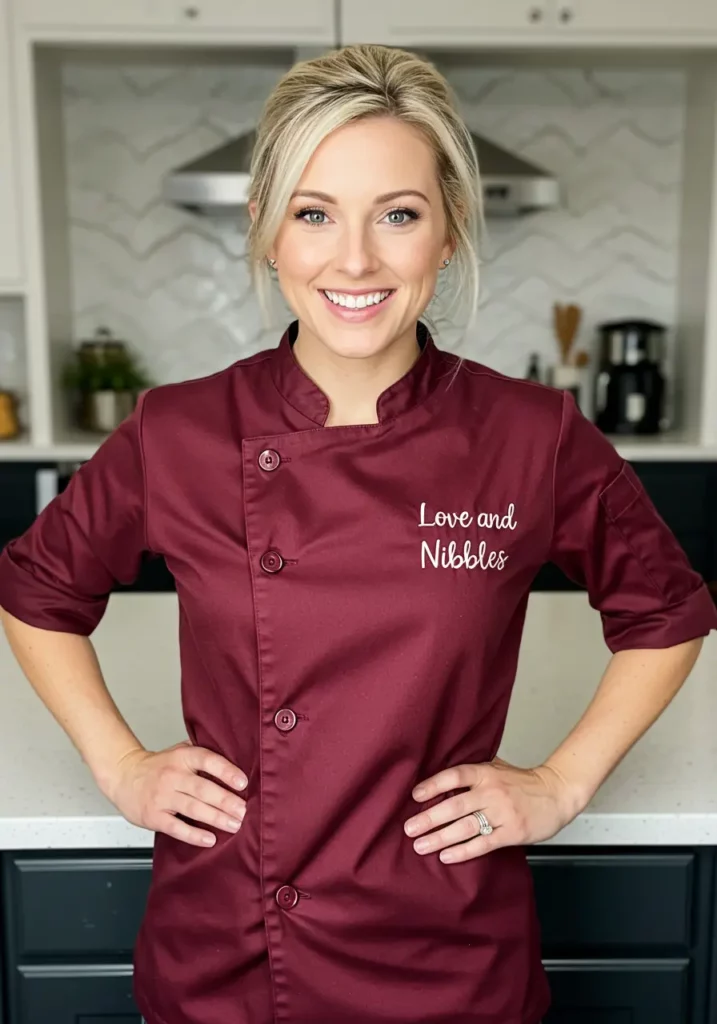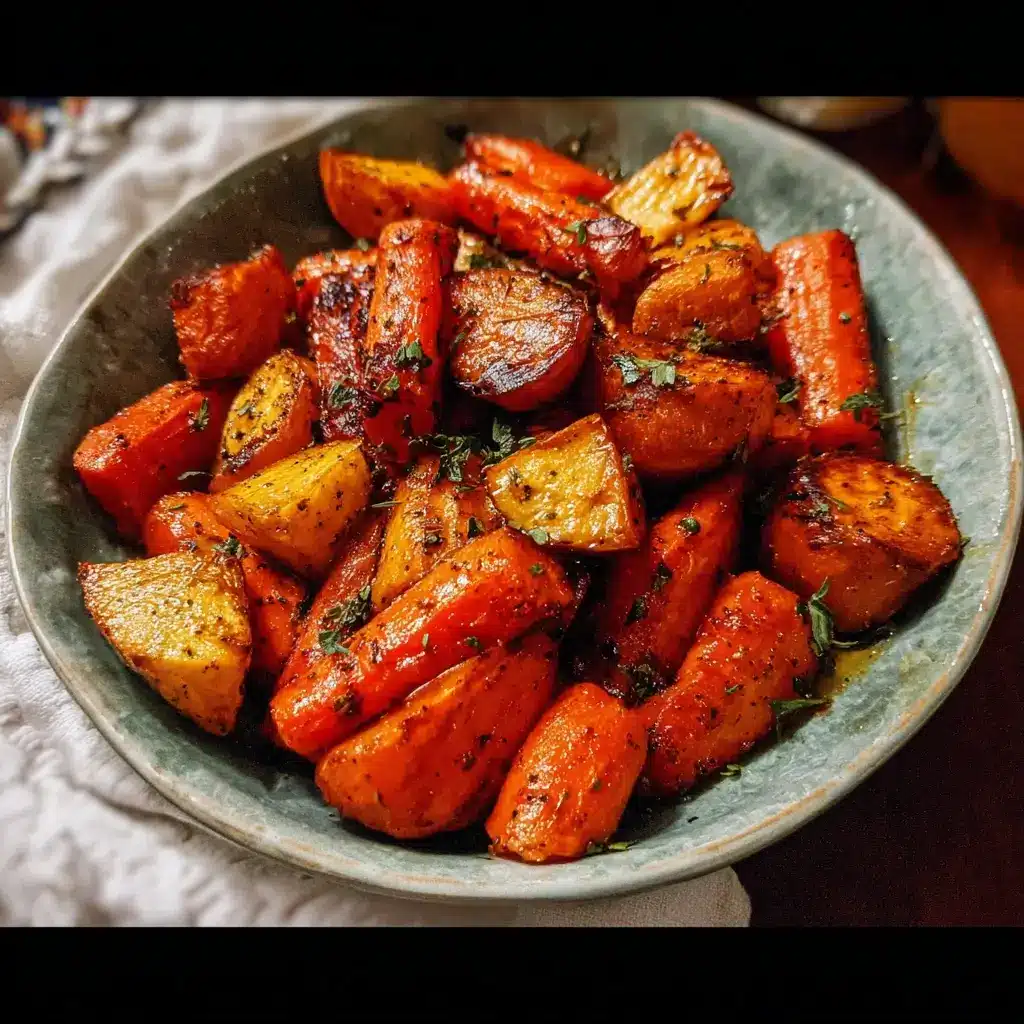Of all the side dishes in my culinary arsenal, there is one that returns to our family table more than any other: Roasted Sweet Potatoes and Carrots. It’s a dish born of simplicity but one that delivers a depth of flavor that feels far more complex. I remember the first time I made it, I was simply trying to use up the last of the vegetables in the crisper drawer before our weekly grocery run. I didn’t expect much, but what came out of the oven was nothing short of magical. The sweet potatoes had transformed, their edges turning into a sticky, caramelized candy, while their centers remained fluffy and soft. The carrots, once firm and earthy, were now tender and intensely sweet, a perfect partner to the potatoes. My kids, who were usually suspicious of anything orange that wasn’t a cheese puff, devoured them without a second thought. Since that day, this recipe has become our go-to for everything from hectic Tuesday night dinners alongside a simple roast chicken to a star player on our Thanksgiving and Christmas buffets. It’s proof that you don’t need fancy ingredients or complicated techniques to create food that is deeply satisfying, nourishing, and universally loved.
The Ultimate Roasted Sweet Potatoes & Carrots Recipe
This recipe is designed to be a reliable foundation. It’s perfectly delicious as is, showcasing the natural sweetness of the vegetables, but it also serves as a canvas for a myriad of flavor variations. The key is in the technique: high heat, proper spacing, and the right amount of oil to achieve that coveted caramelized exterior and tender interior.
Yields: 6 servings
Prep time: 15 minutes
Cook time: 35-45 minutes
Ingredients
- Sweet Potatoes: 2 pounds (about 2-3 medium-large), peeled and chopped into 1-inch cubes
- Carrots: 1.5 pounds (about 6-8 medium), peeled and sliced into 1-inch thick rounds or diagonal pieces
- Olive Oil: 1/4 cup, extra virgin
- Kosher Salt: 1 teaspoon (or to taste)
- Black Pepper: 1/2 teaspoon, freshly ground
- Fresh Rosemary or Thyme: 1 tablespoon, finely chopped (optional, for a savory, aromatic flavor)
- Garlic Powder: 1/2 teaspoon (optional, for a deeper savory note)
Step-by-Step Instructions
Following these steps precisely will ensure you get perfectly roasted, non-soggy vegetables every time. The magic lies in the details, from preheating the oven correctly to not overcrowding the pan.
- Preheat and Prepare: Position two oven racks in the upper and lower thirds of your oven and preheat to 425°F (220°C). High heat is crucial for achieving caramelization and preventing the vegetables from steaming. Line two large, rimmed baking sheets with parchment paper for easy cleanup and to prevent sticking.
- Chop the Vegetables: Wash and peel the sweet potatoes and carrots. Chop them into uniform, 1-inch pieces. Consistency in size is one of the most important steps for even cooking. If some pieces are much larger than others, the small ones will burn before the large ones are tender.
- Season Generously: In a large mixing bowl, combine the chopped sweet potatoes and carrots. Drizzle with the 1/4 cup of olive oil and toss thoroughly to ensure every single piece is lightly coated. A large bowl makes this much easier than trying to toss them on the baking sheet, which often results in an uneven coating and an oily mess. Sprinkle with the kosher salt, black pepper, and optional garlic powder and fresh herbs. Toss again until the seasonings are evenly distributed.
- Arrange for Roasting: Spread the seasoned vegetables in a single layer across the two prepared baking sheets. Do not overcrowd the pans. This is the golden rule of roasting. If the vegetables are too close together or piled up, they will trap steam and become soggy instead of browning and crisping up. It’s better to use two pans than to cram everything onto one.
- Roast to Perfection: Place the baking sheets in the preheated oven. Roast for 35-45 minutes total. After the first 20 minutes, remove the pans from the oven. Using a spatula, flip the vegetables and rotate the pans (move the top one to the bottom rack and vice-versa). This ensures they brown evenly on all sides.
- Check for Doneness: The vegetables are done when they are tender all the way through (easily pierced with a fork) and have developed deeply browned, caramelized edges. The total cooking time will vary depending on the exact size of your vegetable pieces and your specific oven.
- Serve Immediately: For the best texture, serve the roasted sweet potatoes and carrots warm, straight from the oven.
Nutrition Facts
While this is an estimate, it provides a good baseline for this nutrient-dense side dish.
- Servings: 6
- Calories per serving: Approximately 250 kcal
This dish is a powerhouse of nutrition. Sweet potatoes and carrots are famously rich in Beta-Carotene, a precursor to Vitamin A, which is essential for vision, immune function, and skin health. They are also an excellent source of dietary fiber, promoting digestive health and providing a feeling of fullness. The use of heart-healthy olive oil adds beneficial monounsaturated fats.
Preparation & Cooking Time Breakdown
Understanding the time commitment helps with meal planning, especially on busy nights.
- Preparation Time: 15 minutes
- This includes washing, peeling, and chopping the vegetables, as well as seasoning them.
- Cooking Time: 35-45 minutes
- This is the active time in the oven. The only hands-on part during this time is the flip at the 20-minute mark.
- Total Time: 50-60 minutes
The Science of Delicious: Why Roasting Works
Have you ever wondered what makes roasted vegetables so much more delicious than steamed or boiled ones? The answer lies in two fascinating chemical reactions that happen at high temperatures: the Maillard Reaction and Caramelization.
Caramelization is what happens to the natural sugars within the sweet potatoes and carrots. When heated above a certain temperature (around 320°F or 160°C), the complex carbohydrates break down into simpler sugar molecules. These sugars then undergo a series of reactions, creating hundreds of new aromatic compounds that result in a nutty, buttery, and deeply sweet flavor profile. It’s the same process that turns granulated sugar into caramel candy. This is why roasted carrots and sweet potatoes taste so much sweeter than their raw counterparts.
The Maillard Reaction is a reaction between amino acids (the building blocks of protein) and reducing sugars. While vegetables don’t have as much protein as meat, they have enough for this reaction to occur. It’s responsible for the desirable browning and the complex, savory, and toasty flavors that develop on the surface of the vegetables. It’s the same reaction that creates the golden-brown crust on bread and the sear on a steak.
By roasting at 425°F, you are creating the perfect environment for both of these flavor-building reactions to happen simultaneously, transforming humble root vegetables into an irresistibly delicious side dish.
Choosing the Best Ingredients for Maximum Flavor
The quality of a simple dish is entirely dependent on the quality of its ingredients. Here’s what to look for at the grocery store or farmer’s market:
- Sweet Potatoes: Look for small to medium-sized sweet potatoes with smooth, firm skin. Avoid any with soft spots, bruises, or sprouting “eyes.” There are many varieties, but the common orange-fleshed types like Garnet or Jewel are perfect for this recipe due to their moist texture and high sugar content, which aids in caramelization.
- Carrots: Choose firm, bright orange carrots. Avoid any that are limp, rubbery, or have significant cracks. If you buy carrots with their green tops still attached, the greens should look fresh and vibrant, not wilted. Thicker carrots are often sweeter and are easier to chop into uniform pieces for roasting.
- Olive Oil: A good quality extra-virgin olive oil will impart a subtle, fruity, and peppery flavor to the dish. Since it’s a key component, using a quality oil makes a noticeable difference.
How to Serve Your Roasted Vegetables
These roasted sweet potatoes and carrots are incredibly versatile. They can be a simple side, the base of a main course, or even a surprise addition to breakfast.
- As a Classic Side Dish:
- Pair with a Roast Chicken for a quintessential Sunday dinner.
- Serve alongside a seared Steak or Pork Chops. The sweetness of the vegetables beautifully balances the richness of the meat.
- Accompany flaky Baked Salmon or Cod for a healthy, well-rounded meal.
- As a Holiday Staple:
- Place them on your Thanksgiving or Christmas table. They add a vibrant splash of color and a universally loved flavor that complements turkey, ham, and all the other fixings.
- Garnish with a sprinkle of pomegranate seeds and chopped parsley for a festive look.
- In Bowls and Salads:
- Use them as the base for a hearty Grain Bowl. Combine with quinoa or farro, chickpeas, a handful of arugula, and a lemon-tahini dressing.
- Toss the cooled roasted vegetables into a Fall Salad with mixed greens, goat cheese, toasted pecans, and a balsamic vinaigrette.
- Use them in Meal Prep lunches for the week. They hold up well and are delicious warm or at room temperature.
- For Breakfast or Brunch:
- Chop the leftovers and mix them into a Breakfast Hash. Sauté with some onions and peppers, then top with a fried or poached egg.
- Fold them into an Omelette or Frittata along with some spinach and feta cheese.
Flavor Variations to Elevate Your Dish
Once you’ve mastered the basic recipe, feel free to experiment! Here are a few tested variations to inspire you:
- Sweet & Spicy: Add 1 tablespoon of maple syrup and 1/4 teaspoon of cayenne pepper or red pepper flakes to the olive oil before tossing with the vegetables. The combination of sweet, spicy, and savory is addictive.
- Warm & Aromatic: In addition to the salt and pepper, add 1/2 teaspoon of cinnamon and 1/4 teaspoon of nutmeg. This version is particularly wonderful in the autumn and for holiday meals.
- Herby Garlic: Instead of dried herbs and garlic powder, use 3-4 cloves of fresh garlic, minced, and a tablespoon each of fresh rosemary and thyme. Add the fresh garlic during the last 10 minutes of roasting to prevent it from burning.
- Mediterranean Twist: After roasting, while the vegetables are still hot, squeeze the juice of half a lemon over them and toss with 1/4 cup of crumbled feta cheese and a tablespoon of fresh oregano or parsley.
5 Additional Tips for Roasting Perfection
- Ensure Vegetables are Completely Dry: After washing your vegetables, pat them thoroughly dry with a paper towel or a clean kitchen towel. Excess moisture on the surface will create steam in the oven, which is the number one enemy of crispy, roasted vegetables.
- Preheat Your Baking Sheet: For an extra-crispy exterior, place your empty, parchment-lined baking sheets in the oven as it preheats. When you add the seasoned vegetables to the hot pan, they will begin to sizzle and brown immediately, giving you a head start on caramelization.
- Don’t Skimp on the Oil: While you don’t want to drown your vegetables, a sufficient coating of oil is essential. Oil is a conductor of heat, and it helps to transfer the oven’s heat efficiently to the surface of the vegetables, promoting browning and preventing them from drying out. A light, even coating is the goal.
- Embrace the Browning: Don’t be afraid of dark, caramelized spots! Those deep brown edges are where the most intense flavor is concentrated. If your vegetables are tender but still look pale, don’t hesitate to leave them in the oven for another 5-10 minutes until they develop that beautiful color.
- Finish with a Flourish: A simple finishing touch can elevate the entire dish. After roasting, a sprinkle of flaky sea salt (like Maldon) adds a delightful crunch and pop of salinity. A squeeze of fresh lemon or lime juice can brighten up the flavors, while a drizzle of balsamic glaze adds a touch of tangy sweetness.
Frequently Asked Questions (FAQ)
Q1: Can I make these roasted sweet potatoes and carrots ahead of time?
A: Yes, you have two great options. For meal prep, you can peel and chop the vegetables up to 3 days in advance. Store the chopped carrots in a container of water in the fridge to keep them crisp, and store the chopped sweet potatoes in a separate container of water to prevent them from browning. When ready to cook, just drain and dry them thoroughly before proceeding with the recipe. Alternatively, you can fully roast the vegetables, let them cool completely, and store them in an airtight container in the refrigerator for up to 4 days.
Q2: What’s the best way to reheat leftovers so they aren’t soggy?
A: Avoid the microwave if you want to maintain any crispiness! The best way to reheat roasted vegetables is in the oven or an air fryer. Spread them on a baking sheet and heat at 400°F (200°C) for 5-10 minutes, or until warmed through and re-crisped. An air fryer at 375°F (190°C) for 3-5 minutes also works wonderfully.
Q3: My vegetables always turn out soggy. What am I doing wrong?
A: Soggy vegetables are almost always caused by one of three things:
- Overcrowding the pan: This is the most common culprit. The vegetables steam instead of roast. Use two pans if necessary.
- Oven temperature is too low: A lower temperature will slowly cook the vegetables, but it won’t be hot enough to evaporate moisture quickly and trigger the Maillard reaction for browning. Ensure your oven is fully preheated to 425°F.
- Too much moisture: Make sure your vegetables are bone dry before you add the oil.
Q4: Can I use other vegetables with the sweet potatoes and carrots?
A: Absolutely! This recipe is a fantastic template for other root vegetables. Parsnips, red onions, Brussels sprouts, and butternut squash are all excellent additions. Just be mindful of cooking times. Denser vegetables like potatoes and parsnips cook at a similar rate to carrots and sweet potatoes. Softer vegetables like broccoli florets or bell peppers should be added about halfway through the cooking time so they don’t overcook.
Q5: Can I use an air fryer to make this recipe?
A: Yes, an air fryer is perfect for this! You will likely need to cook in batches to avoid overcrowding the basket. Toss the vegetables with oil and seasonings as directed. Preheat your air fryer to 400°F (200°C). Cook for 15-20 minutes, shaking the basket halfway through, until the vegetables are tender and caramelized. The cooking time is significantly shorter in an air fryer, so keep a close eye on them.





